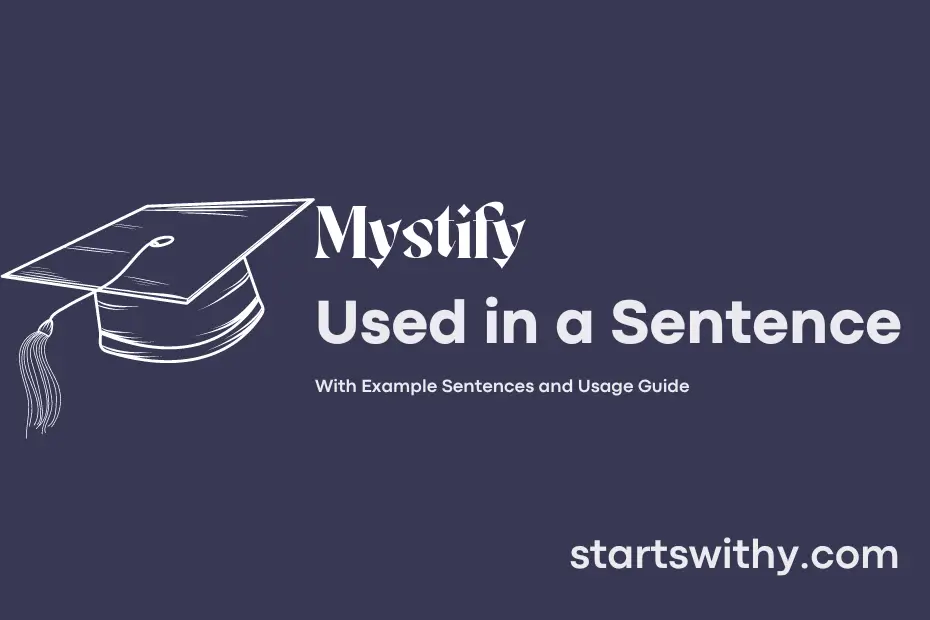Do you find yourself puzzled by the meaning or complexity of certain concepts? If so, you may frequently encounter situations that mystify you. To mystify means to confuse or bewilder someone, often by presenting something as mysterious or difficult to understand.
7 Examples Of Mystify Used In a Sentence For Kids
- The magician’s tricks can mystify us.
- The hidden treasure can mystify explorers.
- A mystery can mystify detectives.
- Some animals can mystify us with their unique abilities.
- Ancient ruins can mystify historians.
- A magic show can mystify children.
- The unknown can mystify us all.
14 Sentences with Mystify Examples
- The complex algorithms used in machine learning can often mystify even the most seasoned computer science students.
- The intricate symbols and equations in quantum physics tend to mystify many college students in India.
- The convoluted regulations of the Indian tax system can mystify even the most diligent accounting students.
- The ancient texts written in Sanskrit can mystify students studying Indian literature and history.
- The cryptic symbols and diagrams in organic chemistry can mystify students trying to understand reaction mechanisms.
- The historical events surrounding India’s independence movement can mystify students learning about the country’s past struggles.
- The complex theories in political science can often mystify students trying to grasp the nuances of governance.
- The intricate dance moves in traditional Indian dances like Bharatanatyam can mystify students learning the art form for the first time.
- The complex rules and strategies in chess can mystify beginners trying to grasp the game’s intricacies.
- The perplexing concepts in Kantian philosophy can mystify students studying western philosophical traditions.
- The diverse cultural practices and traditions in India can often mystify foreign exchange students studying in the country.
- The complicated network of political alliances and conflicts in Indian history can mystify students trying to navigate the country’s past.
- The complex Indian legal system can mystify aspiring lawyers trying to understand the nuances of the judiciary.
- The intricate techniques used in classical Indian music can sometimes mystify students learning to play traditional instruments like the sitar.
How To Use Mystify in Sentences?
To use Mystify correctly in a sentence, first identify a noun or pronoun that you want to describe as mysterious or confusing. For example, “The events of that night continue to mystify me.”
Next, insert the word Mystify into your sentence where it makes the most sense to convey a sense of puzzlement or intrigue. For instance, “The magician’s tricks never fail to mystify the audience.”
Make sure that Mystify is used in the correct form based on the tense and context of your sentence. For instance, you could say, “She has a way of mystifying everyone with her enigmatic smile.”
Remember that the word Mystify is used to describe something that is perplexing or hard to understand. Use it when you want to convey a sense of mystery or confusion in your writing or speech. For example, “The ancient ruins still mystify archeologists to this day.”
Practice using Mystify in different sentences to become more comfortable with incorporating it into your vocabulary. Experiment with different contexts and tenses to fully understand how to use this word effectively.
By following these steps and practicing regularly, you can confidently incorporate the word Mystify into your everyday language to add depth and intrigue to your communication.
Conclusion
In conclusion, sentences that mystify often leave readers puzzled or confused due to their complex or ambiguous nature. These sentences can contain intricate language, unusual phrasing, or unclear meanings that may require careful analysis to fully comprehend. By crafting sentences that mystify, writers can evoke a sense of mystery, intrigue, or bewilderment in their readers, prompting them to delve deeper into the text to unravel its secrets and uncover hidden layers of meaning. However, it is important to strike a balance between intrigue and clarity in writing to ensure that the intended message is effectively communicated without causing unnecessary confusion.
Overall, sentences that mystify can add depth and interest to a piece of writing, but they should be used judiciously to enhance the reader’s experience rather than impede their understanding. By mastering the art of crafting enigmatic sentences, writers can engage their audience and spark curiosity, inviting them to decipher the mystique within the text and discover new insights lurking beneath its perplexing surface.



